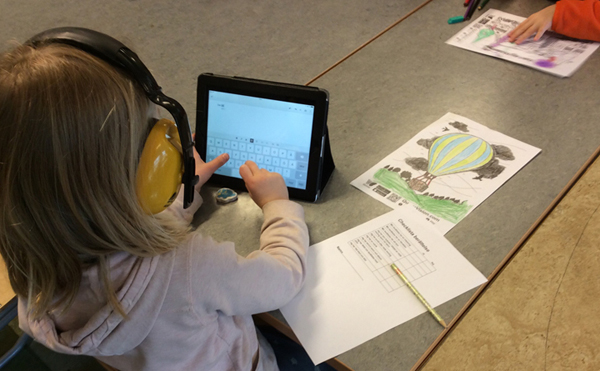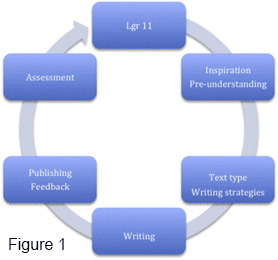Write to learn
Om projektet
Projektuppgifter
Projektstatus
Pågående
Kontaktperson
Forskningsämne
Forskningsmiljöer
Write to learn – using ICT to improve learning in early ages
“Write to Learn” method (WTL) is an innovative method developed with the aim of letting ICT serve as a leverage for pedagogical learning factors. WTL lets children from 1st grade collaborate using digital tools in order to write texts and subsequently discuss and refine them together with classmates and teachers using digital real-time formative feedback and assessment. The central learning factor addressed, in mathematics as well as in literacy, is the written communication allowing the learners to interact with peers and teachers.
The method draws on methods from socio-cultural theory, including continuous social interaction and written real-time formative feedback among peers, using shared electronic forums for collaboration, thereby providing social meaning and increased learning of literacy and mathematics, among both boys and girls.
WTL has been successfully practiced in literacy and mathematics training over several years in Sollentuna.

WTL research at ORU
WTL research at ORU (Örebro University) has been conducted aiming at measuring the effects of the method.
Research has shown improvements of student performance on national standard tests in both mathematics and literacy by some 20%. In particular, low performers have improved which means the gap between them and high and average performers has been reduced. Two publications are available, Grönlund & Agélii Genlott (2013) and Agélii Genlott & Grönlund (2016).
The structure of WTL
The WTL method is based on the goals of the Swedish National curriculum (Lgr 11), and it uses active writing, publishing, peer feedback and formative assessment as main distinctive components. Supporting components include inspiration and preunderstanding, text genres, and writing strategies. Figure 1 illustrates the general work process by which lessons should be carried out.

The WTL method. Lgr 11 is the Swedish National curriculum.
1. First, the teacher plans the lessons by choosing which abilities, core content, and knowledge requirements, in accordance with the curriculum (Lgr 11), that are the aim of the lessons. It is important that the teacher helps students understand what they are aiming at. The goals of the work must be clearly specified and documented, e.g. on the classroom wall.
2. Second, the teacher shall inspire the students in conjunction with setting the topic. At the same time the teacher shall give the students examples from the genre to be produced in order to create a preunderstanding among the students.
3. Before the students begin writing it it's important to give them knowledge about how that particular text genre is to be written. For example, what kind of words are suitable to use in this context, who will be reading such a text, etc.
4. After making this introduction the students begin writing while getting linguistic support from the teacher and feedback from both their peers and the teacher.
5. Depending on topic and type of assignment the texts can either be published directly on the class web site or written in a document shared with teachers and peers, two ways to make communication and feedback possible during the writing phase. Either way, after the texts are published different kinds of feedback from the receivers is mandatory. The purpose is to make sure the students know that they are writing for real readers, and that they will get written feedback directly after publishing their texts.
6. Finally, the work is formatively assessed by the teacher and the students.
Teachers training course
In order to make sure the method is sufficiently equally delivered across schools there is need for teacher training. In the Sollentuna case, some 100 teachers were trained in using the WTL method over a 5-year period, and currently (2016-17) teachers from ten more cities in Sweden are being trained under the auspices of the Swedish Association of Local and Regional Authorities. Dissemination of the method by means of e.g. a book is not enough. Research has shown that the course method used for teacher training – which is basically the same as the one used for teaching the children – has worked well. Method retention after 5 years is high; teachers who have started using the method continue to do so (Agélii & Grönlund, 2016b – in press).
For the current nation-wide training course some digital material has been produced, including a number of videos and a web site with social forums for interaction, all for the purpose of making training accessible over distance and in asynchronous mode in a way that makes is as similar as possible to the on-site training conducted in Sollentuna.
References
Grönlund, Å., Agélii Genlott, A. (2013) Improving literacy skills through learning reading by writing: The iWTR method presented and tested. Computers & Education. Volume 67, September 2013, Pages 98–104. DOI:10.1080/17439884.2012.756518. http://dx.doi.org/10.1016/j.compedu.2013.03.007
Agelii Genlott, A., Grönlund, Å. (2106) Closing the gaps: Improving literacy and mathematics by ict-enhanced collaboration, Computers and education, ISSN 0360-1315, E-ISSN 1873-782X
Agelii Genlott, A., Grönlund, Å. (2016b) Disseminating technology-driven innovation in school – Managing Change of the Second-Order (in press).
